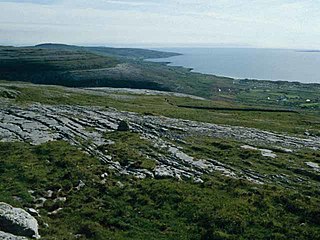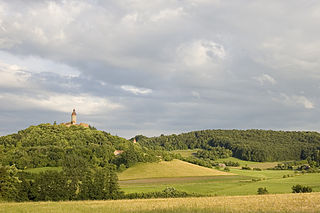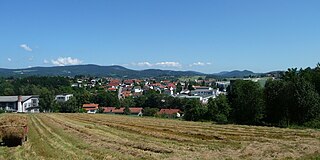The Upper Palatine-Upper Main Hills (German : Oberpfälzisch-Obermainisches Hügelland), also called the Upper Palatine-Upper Main Hills and Uplands (Oberpfälzisch-Obermainisches Hügel- und Bergland) form a landscape of low, rolling hills between the Franconian Jura in the southwest and (from northwest to southeast) the Franconian Forest, Fichtel Mountains and Upper Palatine Forest in the northeast.

German is a West Germanic language that is mainly spoken in Central Europe. It is the most widely spoken and official or co-official language in Germany, Austria, Switzerland, South Tyrol (Italy), the German-speaking Community of Belgium, and Liechtenstein. It is also one of the three official languages of Luxembourg and a co-official language in the Opole Voivodeship in Poland. The languages which are most similar to German are the other members of the West Germanic language branch: Afrikaans, Dutch, English, the Frisian languages, Low German/Low Saxon, Luxembourgish, and Yiddish. There are also strong similarities in vocabulary with Danish, Norwegian and Swedish, although those belong to the North Germanic group. German is the second most widely spoken Germanic language, after English.

The Franconian Jura is an upland in Bavaria, Germany. Located between two rivers, the Danube in the south and the Main in the north, its peaks reach elevations of up to 600 metres (2,000 ft) and it has an area of some 7053.8 km2.

The Franconian Forest, is a mid-altitude mountain range in Northern Bavaria, Germany. It is located in the district of Upper Franconia (Oberfranken) and forms the geological connection between the Fichtelgebirge and the Thuringian Forest. It is a broad well-wooded plateau, running for about 45 kilometres (28 mi) in a northwesterly direction, descending gently on the north and eastern sides towards the Saale river, but more precipitously to the Bavarian plain in the west, and attaining its highest elevation in the Döbraberg near Schwarzenbach am Wald. Along the centre lies the watershed between the basins of the Main and the Saale, belonging to the systems of the Rhine and Elbe respectively.
Contents
The region runs from northwest to southeast and is about 170 kilometres long, but only 7 to 35 kilometres wide [1] and lies mainly in the Bavarian administrative provinces of Upper Franconia and Upper Palatinate; small elements, however, also lie within the Thuringian county of Sonneberg. Its best known settlements are (from northwest to southeast) Sonneberg (in the extreme northeast), Kulmbach, Marktzeuln near Lichtenfels (at the northwest edge), Bayreuth, Weiden (Ostrand), Amberg and Schwandorf.

Bavaria, officially the Free State of Bavaria, is a landlocked federal state of Germany, occupying its southeastern corner. With an area of 70,550.19 square kilometres, Bavaria is the largest German state by land area comprising roughly a fifth of the total land area of Germany. With 13 million inhabitants, it is Germany's second-most-populous state after North Rhine-Westphalia. Bavaria's main cities are Munich and Nuremberg.

Upper Franconia is a Regierungsbezirk of the state of Bavaria, southern Germany. It forms part of the historically significant region of Franconia, all now part of the German Federal State of Bayern (Bavaria).

The Upper Palatinate is one of the seven administrative districts of Bavaria, Germany, located in the east of Bavaria.













